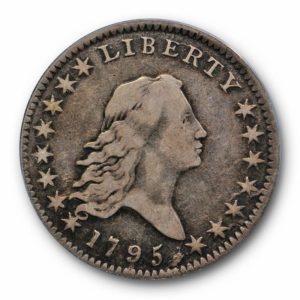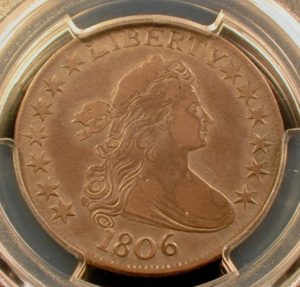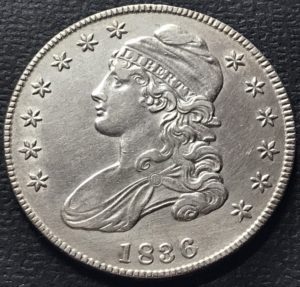Early Half Dollars – Flowing Hair, Draped Bust, and Capped Bust
Flowing Hair Half Dollar
 The Silver Half Dollar began circulation in 1794 with the Flowing Hair design. Congress wanted a coin that would be “emblematic of liberty”. The Flowing Hair silver half dollar gets its name directly from the imagery on the coin’s face. The half dollar, was designed by Chief Engraver at the time, Robert Scot, and features a young woman with flowing hair that represents freedom. Due to the rudimentary technology used to produce the Flowing Hair Silver Half Dollar, they tend to wear unevenly and for that reason they pose a challenge for modern day collectors looking to grade them. Those looking to grade these coins should be mindful of wear in Liberty’s hair and the eagle’s breast. Though this coin was beautiful and representative of Congress’ vision, the Union was in flux and so was the design of currency.
The Silver Half Dollar began circulation in 1794 with the Flowing Hair design. Congress wanted a coin that would be “emblematic of liberty”. The Flowing Hair silver half dollar gets its name directly from the imagery on the coin’s face. The half dollar, was designed by Chief Engraver at the time, Robert Scot, and features a young woman with flowing hair that represents freedom. Due to the rudimentary technology used to produce the Flowing Hair Silver Half Dollar, they tend to wear unevenly and for that reason they pose a challenge for modern day collectors looking to grade them. Those looking to grade these coins should be mindful of wear in Liberty’s hair and the eagle’s breast. Though this coin was beautiful and representative of Congress’ vision, the Union was in flux and so was the design of currency.
Draped Bust Half Dollar
 In 1796, a new half dollar was introduced: the draped bust. This coin featured a draped bust on one side and a small eagle on the other. It is a rare coin because it was only produced for two years and was not widely circulated. This version of the silver dollar was produced with the same technology as its younger counterpart and thus has some of the same issues when it comes to uneven wear. Collectors are encouraged to pay special attention to the hair and the eagle’s breast for wear when grading the currency. This coin was upgraded to include a “heraldic eagle” and the draped bust with the heraldic eagle version of the silver half dollar was produced from 1801-1807. As technology developed so did the aesthetic of the silver dollar which led to its next iteration, the Capped Bust.
In 1796, a new half dollar was introduced: the draped bust. This coin featured a draped bust on one side and a small eagle on the other. It is a rare coin because it was only produced for two years and was not widely circulated. This version of the silver dollar was produced with the same technology as its younger counterpart and thus has some of the same issues when it comes to uneven wear. Collectors are encouraged to pay special attention to the hair and the eagle’s breast for wear when grading the currency. This coin was upgraded to include a “heraldic eagle” and the draped bust with the heraldic eagle version of the silver half dollar was produced from 1801-1807. As technology developed so did the aesthetic of the silver dollar which led to its next iteration, the Capped Bust.
Capped Bust Half Dollar
 The capped bust silver half dollar design was very popular and admired when it began production and the coin is still popular among collectors. There are two versions of the capped bust silver half dollar. The first has a lettered edge and was minted from 1807 until 1836. This version was struck with a minting tool called the screw press. The second version has a reeded edge. The reeded edge version was minted from 1836 until 1839. The coin’s reeded edge is a direct result of the way that it was produced. Instead of being minted with the screw press, the reeded edge coin was produced with the steam press. The steam press was fantastic for mass production but did not leave room for individual touches like older technologies did and thus instead of a lettered edge this new version has a reeded edge. Both versions of the coin boasted a capped bust on one side and an eagle on the other. Collectors should check for wear on the capped busts itself when grading this currency, specifically the “drapery at the front of the bust, the shoulder clasp and the cap and hair above the eye”. Wear can also be found in the edges of the eagle’s wings and on the eagle’s talons.
The capped bust silver half dollar design was very popular and admired when it began production and the coin is still popular among collectors. There are two versions of the capped bust silver half dollar. The first has a lettered edge and was minted from 1807 until 1836. This version was struck with a minting tool called the screw press. The second version has a reeded edge. The reeded edge version was minted from 1836 until 1839. The coin’s reeded edge is a direct result of the way that it was produced. Instead of being minted with the screw press, the reeded edge coin was produced with the steam press. The steam press was fantastic for mass production but did not leave room for individual touches like older technologies did and thus instead of a lettered edge this new version has a reeded edge. Both versions of the coin boasted a capped bust on one side and an eagle on the other. Collectors should check for wear on the capped busts itself when grading this currency, specifically the “drapery at the front of the bust, the shoulder clasp and the cap and hair above the eye”. Wear can also be found in the edges of the eagle’s wings and on the eagle’s talons.
